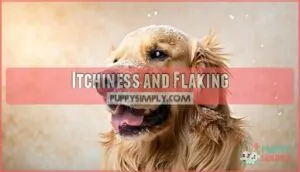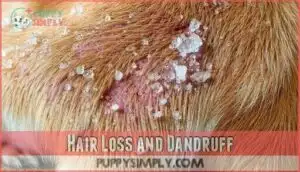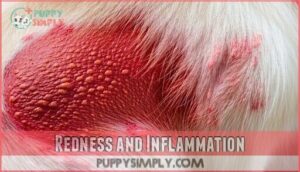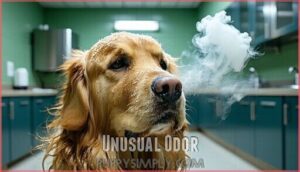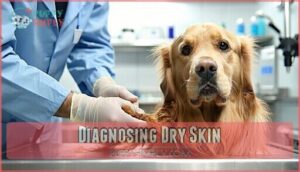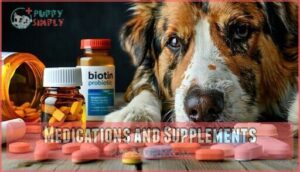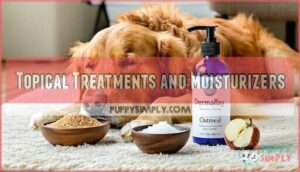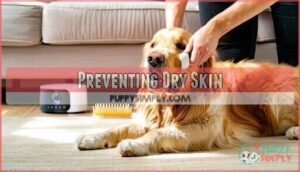This site is supported by our readers. We may earn a commission, at no cost to you, if you purchase through links.
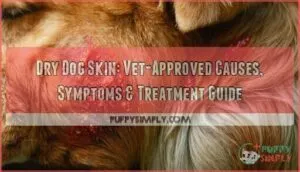
Symptoms often include itchiness, flakes, redness, and even hair loss. To help, you’ll want to start with a vet check-up to rule out underlying issues and get personalized advice.
In the meantime, try a gentle, moisturizing dog shampoo and make sure their diet is packed with healthy fats. Keep an eye on them—prevention’s easier than fixing a flare-up. And remember, sometimes the smallest changes can work wonders!
Table Of Contents
- Key Takeaways
- Causes of Dry Skin
- Symptoms of Dry Skin
- Diagnosing Dry Skin
- Treating Dry Skin
- Preventing Dry Skin
- Frequently Asked Questions (FAQs)
- What can I give my dog for dry skin?
- How do you moisturize a dry dog?
- What is the best moisturizer for dog dry skin?
- How do you hydrate a dog’s fur?
- What is the best type of diet for a dog with dry skin?
- How often should I bathe my dog to help with dry skin?
- Can dry skin be triggered by stress in dogs?
- Do outdoor activities worsen dry skin conditions?
- How do seasonal changes impact canine skin health?
- Are there specific grooming tools that help with dryness?
- Conclusion
Key Takeaways
- Identify the root cause of your dog’s dry skin by consulting a vet and monitoring symptoms like flakes, redness, hair loss, or unusual odors.
- Use a moisturizing oatmeal-based shampoo, apply vet-approved conditioners, and avoid harsh products to keep your dog’s skin healthy and hydrated.
- Feed a balanced diet rich in omega-3 fatty acids, vitamins, and high-quality proteins to support skin health and combat dryness.
- Prevent dryness with regular grooming, proper hydration, flea control, and minimizing exposure to environmental factors like low humidity or extreme weather.
Causes of Dry Skin
Your dog’s dry skin can stem from multiple factors, including allergies, parasites, environmental conditions, and underlying health issues.
Dry skin in dogs often signals allergies, parasites, or health issues—early care ensures comfort and a healthier coat.
Understanding these root causes helps you identify the right treatment approach and prevent future skin problems, which is crucial for your dog’s overall health and wellbeing, especially when considering underlying health issues.
Allergies in Dogs
Several types of allergies can trigger dry skin in your dog, making them scratch and feel uncomfortable.
Food allergies and environmental allergens are common culprits that lead to atopic dermatitis.
- Food allergies develop when your dog’s immune system reacts to specific proteins in their diet
- Environmental allergens like pollen, dust mites, and mold spores cause seasonal flare-ups
- Atopic dermatitis creates chronic inflammation that dries out your dog’s skin barrier
- Allergy testing helps identify specific triggers through blood tests or skin prick tests
- Immunotherapy options provide long-term relief by gradually desensitizing your dog’s immune system
Parasites and Infections
External parasites in dogs create havoc on your pet’s skin.
Mite infestations like Demodex mite and canine scabies cause intense scratching and flaking.
Bacterial infections and yeast overgrowth exploit weakened skin barriers.
Ringworm symptoms include circular lesions despite being fungal, not parasitic.
Mange spreads quickly between pets.
Preventative medications and parasite control keep these skin destroyers at bay, including managing mite infestations.
Systemic Disorders
Your dog’s dry skin might signal deeper health issues lurking beneath the surface.
Cushings disease disrupts hormone production, while hypothyroidism slows metabolism and affects skin health.
Autoimmune diseases cause your pet’s immune system to attack healthy tissue.
Cancer and other metabolic diseases create endocrine imbalances that manifest as skin problems.
Organ dysfunction often shows up first through coat changes, which can be a sign of deeper health issues or Cushings disease.
Breed-Specific Conditions
Genetic predispositions make certain breeds more vulnerable to skin problems.
Hairless breeds like Chinese Crested dogs need extra moisturizing, while Huskies often develop zinc-responsive dermatosis. Bulldogs require careful cleaning of skin folds to prevent infections.
Your dog’s breed research helps identify potential issues early. Always schedule veterinary consultation for breed-specific health concerns and proper treatment plans, which can help address issues like skin problems.
Environmental Factors
Beyond genetics, your home’s atmosphere plays a major role in your dog’s skin health.
Cold weather and forced-air heating systems create the perfect storm for dry skin by stripping moisture from the air.
Four key environmental factors affect your pup’s skin:
- Low humidity from indoor heating during winter months
- Dry air circulation that removes natural skin moisture
- Seasonal changes that shift temperature and humidity levels
- Sun exposure causing dehydration and skin damage
Symptoms of Dry Skin
You’ll notice several clear signs when your dog develops dry skin, including excessive scratching, visible flakes or dandruff in their coat, and areas of redness or irritation.
These symptoms often appear together and can range from mild itchiness to more serious issues like hair loss, scabs from scratching, and unusual odors that signal underlying skin problems.
Note: I have bolded the word "itchiness" as a key phrase to help a reader skim the text.
Itchiness and Flaking
When your dog’s skin becomes dry, you’ll notice the telltale signs of constant scratching and visible flaking.
This itchy dog skin creates a frustrating cycle where scratching worsens the condition, leading to more irritation.
A good start is to use allergy-friendly shampoos to alleviate the discomfort.
| Scratching Severity | Dandruff Appearance | Coat Condition |
|---|---|---|
| Mild occasional scratching | Light white flakes | Slightly dull fur |
| Frequent scratching sessions | Thick, visible dandruff | Patchy, rough texture |
| Constant scratching/biting | Large, oily flakes | Brittle, breaking hair |
Watch for behavioral changes and secondary infections from excessive scratching.
Hair Loss and Dandruff
While scratching brings temporary relief, you’ll often notice more alarming changes developing.
Hair loss and dandruff signal your dog’s skin isn’t functioning properly. Alopecia patterns vary from small bald patches to widespread thinning, while dandruff causes range from poor nutrition to serious infections affecting skin cell turnover.
Watch for these warning signs:
- Patchy hair loss – Circular bald spots or thinning areas where coat texture changes dramatically
- White flakes – Visible dandruff scattered through fur during brushing or petting sessions
- Excessive skin scaling – Large, visible flakes that accumulate on your dog’s bedding
- Brittle hair – Coat breaks easily when touched, indicating compromised hair regrowth cycles
- Dull appearance – Loss of natural shine suggests underlying dry dog skin conditions affecting follicles
Redness and Inflammation
Red, irritated skin signals your dog’s body is fighting something—whether allergies, infections, or other inflammation causes.
Red, irritated skin often signals an underlying issue—stay proactive with care to ensure your dog’s comfort and health.
You’ll notice warm, pink-to-red patches that feel tender to the touch.
Dog skin redness often appears alongside scratching, making the skin inflammation worse, and some breeds show predisposition to these inflammation issues.
So veterinary care helps identify infection signs and provide proper redness relief treatment.
Unusual Odor
A bad smell can mean more than just bath time.
Yeast infections, bacterial overgrowth, or even impacted anal glands may lead to dog skin odor.
Dental disease or diet impact can worsen the situation.
Dry dog skin can also trap odors.
If your dog’s skin problems include a persistent skin odor, consult your vet to rule out underlying causes.
Diagnosing Dry Skin
To diagnose dry skin in your dog, start by consulting a veterinarian for a thorough physical examination.
They may recommend tests like skin scraping or a biopsy to identify the underlying cause.
Physical Examination
A veterinarian’s physical examination is key to understanding dog skin problems.
During the check-up, they’ll assess the coat’s health, test skin elasticity for hydration issues, and inspect for lesions causing dog dry skin.
Here’s what they’ll do:
- Examine for redness and scaling.
- Check hydration through skin elasticity.
- Observe lesions or sores.
- Palpate to detect hidden problems.
To alleviate discomfort, consider gentle bathing techniques.
Skin Scraping and Biopsy
Microscopic analysis through skin scraping or a dog skin biopsy is key to understanding dog skin problems.
A vet collects samples from affected areas, examining them for parasites, infections, or inflammation. Though the procedure risks minor discomfort, the diagnostic value is huge for accurate dog skin diagnosis.
This process guarantees better interpretation accuracy, guiding targeted treatments for your dog’s skin health, which is crucial for overall dog skin diagnosis and care.
Treating Dry Skin
Treating your dog’s dry skin starts with addressing the root cause, whether it’s diet, allergies, or grooming habits.
A combination of proper nutrition, gentle shampoos, and vet-recommended topical treatments can help restore their skin to a healthy state, which is the ultimate goal of treating your dog’s dry skin.
Balanced Diet and Nutrition
A high-quality diet rich in essential fatty acids and adequate protein intake is key for healthy dog skin.
Watch for vitamin deficiencies, as they often worsen dryness. Hydration importance matters too—mix wet food with kibble to increase moisture.
Choose dog skin nutrition meeting AAFCO standards to prevent nutritional deficiencies.
Customized supplements can also support your dog’s overall skin health.
Medications and Supplements
Restoring your dog’s skin health can feel easier with the right tools.
Dog skin supplements like fish oil for dogs deliver much-needed Omega-3 fatty acids. Probiotics for dogs improve immunity and reduce inflammation. Prescription options may target specific issues.
Always choose high-quality supplements. Many owners find fish oil beneficial for their pets.
- Fish oil: Rich in Omega-3 fatty acids.
- Biotin: Promotes healthy fur.
- Vitamin E: Soothes irritation.
- Probiotics: Boost gut and skin health.
Gentle Shampoos and Conditioners
If your dog’s dry skin has you worried, grab a sulfate-free dog shampoo.
Oatmeal shampoos naturally soothe itchiness, while medicated shampoos tackle infections.
Follow up with a dog conditioner to lock in moisture—think of it as skin moisturizer for your furry friend.
You could even explore gentle DIY recipes, but always make certain they’re safe for pets!
For quick clean-ups between baths, consider using dry dog shampoo.
Topical Treatments and Moisturizers
For dry skin relief, try dog skin moisturizers like Dermallay Oatmeal Spray Conditioner or coconut oil, which soothe and heal.
Vitamin E and olive oil work wonders as emollients, while humectants like apple cider vinegar lock in moisture.
Consider specialized moisturizers for dogs to address specific skin conditions.
Stick to dog skin care products like oatmeal shampoos or conditioners to avoid irritation, and always consult your vet before using essential oils for dry skin relief.
Preventing Dry Skin
Preventing dry skin in your dog starts with simple, consistent care and attention to their needs.
By maintaining a proper grooming routine, providing balanced nutrition, and protecting their skin from harsh products and environmental factors, you can keep their coat healthy and irritation-free.
Regular Grooming and Hydration
Regular brushing benefits your dog’s skin by distributing natural oils, reducing flakes, and improving circulation.
Grooming frequency should match your dog’s coat type—weekly for short hair, daily for long. Providing fresh water supports skin hydration from within.
Consider using a dog skin moisturizer after baths. Professional grooming guarantees thorough care and enhances dog skin care if dry skin persists.
Oatmeal baths can soothe itchy skin during grooming, which helps with dry skin and overall skin hydration.
Avoiding Harsh Products
Did you know harsh products can worsen your dog’s dry skin?
Opt for safe ingredients and pH-balanced, soap-free options to maintain dog skin health.
Natural alternatives like oatmeal-based shampoos or DIY recipes with coconut oil can be soothing.
For best care, consider a soap free dogwash.
Prioritize natural dog skin care to avoid irritation and maximize dog skin moisturizer benefits for healthier, hydrated skin.
Choose wisely!
Year-Round Flea Prevention
Flea prevention matters year-round for dog skin health. Fleas thrive in all seasons, completing their life cycle quickly.
Use preventative medications regularly as per veterinary recommendations. Pair this with environmental control—clean bedding and vacuuming can reduce flea eggs.
Don’t overlook resistance management; alternate treatments if necessary. Consistent care prevents dog itchy skin and keeps their skin healthy. Stay proactive!
Monitoring Skin Condition
Pay attention to your dog’s coat quality changes, scratching habits, and signs like skin flaking or scaling.
Regular visual skin checks help spot dryness early, alongside hydration level tests to confirm proper moisture.
Don’t skip veterinary follow-ups—sometimes a quick visit reveals hidden issues.
Consistent monitoring and timely dog skin treatment keep your furry friend comfortable and their skin healthy.
Frequently Asked Questions (FAQs)
What can I give my dog for dry skin?
Oddly enough, a balanced diet works wonders!
Add omega-3 fatty acids through fish oil, use oatmeal-based shampoos for baths, and keep your dog hydrated.
A vet-approved moisturizer or supplement can also soothe dry, itchy skin.
How do you moisturize a dry dog?
Start with a gentle, vet-approved moisturizing shampoo or an oatmeal-based variety.
After bathing, apply a dog-safe skin moisturizer or coconut oil.
Regular brushing helps natural oils spread evenly, keeping your dog’s skin hydrated and healthy.
What is the best moisturizer for dog dry skin?
Investigating what works, a vet-approved oatmeal-based moisturizer often tops the list.
It soothes irritation, locks in moisture, and is safe for dogs.
Pair it with a proper diet and hydration for long-term skin health.
How do you hydrate a dog’s fur?
Brush your dog regularly to distribute natural oils, bathe with moisturizing shampoo, and use vet-approved conditioners.
Boost hydration with omega-3 supplements, a balanced diet, and plenty of water.
Avoid overbathing to prevent stripping oils.
What is the best type of diet for a dog with dry skin?
Feed your dog a balanced diet rich in omega-3 and omega-6 fatty acids, high-quality protein, and essential vitamins.
Include fish oil or flaxseed supplements, and choose foods certified by the AAFCO for superior nutrition.
How often should I bathe my dog to help with dry skin?
Bathing your dog every 3-4 weeks is ideal for managing dry skin.
Use a gentle, moisturizing shampoo specifically for dogs, and avoid overbathing to prevent stripping natural oils that help keep their skin healthy.
Can dry skin be triggered by stress in dogs?
Stress can spark changes in your dog’s body, like a storm brewing under the surface.
It can trigger dry skin by altering hormone levels or suppressing immunity, making your pup more prone to irritation and flakiness.
Do outdoor activities worsen dry skin conditions?
Yes, outdoor activities can worsen dry skin in dogs, especially in hot, dry, or cold weather.
Harsh elements like sun, wind, or allergens strip natural oils, leaving skin vulnerable.
Keep outings short and moisturize regularly.
How do seasonal changes impact canine skin health?
Did you know cold, dry air in winter can triple your dog’s chance of flaky skin?
Seasonal changes, like harsh winds or low humidity, strip natural oils, while hot summers exacerbate dehydration, worsening skin issues.
Are there specific grooming tools that help with dryness?
Use grooming tools like soft-bristle brushes or rubber curry combs to remove dead skin and hair gently.
A fine-toothed comb helps with tangles, while moisturizing sprays or wipes can restore hydration during grooming sessions.
Conclusion
Did you know that over 20% of dogs experience dry skin during their lives?
Tackling dry dog skin doesn’t have to be complicated. Start by identifying the cause with your vet’s help, then focus on soothing care like nutrient-rich diets and gentle shampoos.
Regular grooming, hydration, and preventive measures can make all the difference in maintaining healthy skin. By staying observant and proactive, you’ll keep your pup itch-free and comfortable, ensuring their coat stays healthy and vibrant year-round.
- http://www.merckvetmanual.com/pethealth/dog_disorders_and_diseases/skin_disorders_of_dogs/diagnosis_of_skin_disorders_in_dogs.html
- https://veterinary.rossu.edu/about/meet-our-faculty-staff/juliette-bouillon
- http://herovetawards.org/judges/dr-ann-eliopulos-dvm/
- https://www.ncbi.nlm.nih.gov/pubmed/25607907
- https://nationaleczema.org/get-facts-acv/

